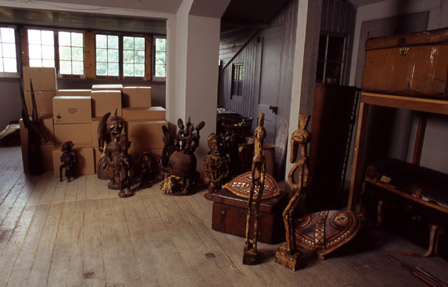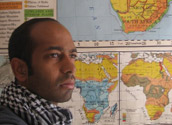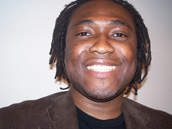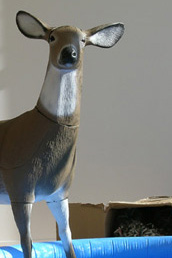Art
Brendan Fernandes

Unsettled
The Spirit behind the Mask
Michelle Rackham in conversation with Brendan Fernandes
Michelle Rackham: It's been at least ten years since we last saw each other, Brendan. I can't recall the date of our last meeting but I'm sure it was back in the late nineties, when we used to dance together at the Peter Stanton School of Dance in Newmarket, ON. Since then, you've completed a BFA at York University and an MFA at the University of Western Ontario, launched a successful career as an installation artist, and you were recently shortlisted for the Sobey Award. I'd say you've been pretty busy!
Brendan Fernandes: Yes, it has definitely been a long time since our last encounter. I think it has to have been at the Peter Stanton School of Dance in Newmarket. I recall those days very fondly.
MR: Before you lived in Newmarket though, you spent your earliest years in Kenya, where you were born. Moving from Kenya in 1989 to Newmarket, ON - on the fringes of the Greater Toronto Area, what was a predominantly white, middle class suburb in the 1990s - I imagine must have been a bit of a culture shock for you. How has that experience affected you as a person and as an artist?
BF: In Kenya, I lived in Nairobi. Having to leave a city and move to a smaller town like Newmarket was a challenge. I encountered many stereotypical ideas of where I had come from (Africa). For example, my elementary school colleagues would automatically assume that I lived in a primitive jungle with elephants and other animals. These assumptions are fuelled by stereotypical ideas about Africa. In all essence, I was the one coming from a metropolitan city and settling into a smaller town.
Being a minority in Newmarket was also something that I had to attend to but not to the same extent as class. The people of Newmarket had a middle to upper-middle class structure and, as immigrants, my family slowly had to acclimatize ourselves to our new socio-economic surroundings. These things definitely affected the ways in which I make art. I constantly look back at how I negotiated myself as a Kenyan and a Canadian in my early school days. I definitely wanted to fit in with my new school friends and would even try to change my accent to sound like them. These experiences have influenced my research and can be seen in projects such as Foe, where I hired an acting coach to teach me to speak in my cultural accents.
MR: What led you to become a conceptual artist? Did you train or work in other media/modes prior to taking up conceptual art? Or is this something you have always been doing?
BF: I think it is funny that you call me a conceptual artist. I guess my work deals with theories and concepts so I like the term.
My work always begins with questions. I started out as a painter and, in graduate school, I moved into an installation practice. I have always been interested in critical theory and that has given me a means to approach ideas in my work, to formulate and ask complex, layered questions. When studying at the Whitney Independent Study Program, I was able to further develop this criticality by engaging within a focused environment of fellow artists, theorists, and curators. So I guess it was a process of questions that lead me to what I do today. I never have answers to my questions as they allow for my practice to continue and grow.
MR: A number of your installations appear to engage with the idea of performance and/or performativity. How do you see performance operating in your works?
BF: I see my work engaging in the act of performance mainly in pieces where I am using my body. In them, it seems that I am always documenting a process, whether it be tanning or receiving lessons on how to adopt an accent. The works are shown as videos, I never perform live - or I have not as yet. In them, I use aspects of chance mainly by having my audience engage with the video or installation. I have done this in the past with the use of multiple takeaways. For example, in my installation Foe I have a poster available that has the script of the video written out phonetically. Many times my audience stands in front of the video and tries to follow the script via the poster. If they read the poster aloud, they then begin to adopt a change of speech; in that regard, they are complying and participating. So the act of performance is passed on from the video to the audience.
MR: Speaking of performance, are you still dancing today? Also, do you see your experiences as a dancer informing your art work aesthetically, conceptually or otherwise?
BF: I did continue to dance after leaving Newmarket. In my undergraduate at York University, I majored in Visual Arts but took a number of technique classes in Ballet and Modern Dance (Martha Graham and Jose Limon) with majors in the program.
Since my undergraduate I have not danced but it has definitely given me a lot to consider in my visual arts practice. I work predominately as an installation artist and considering space is something that I am constantly negotiating. Dance not only gave me the ability to understand my body but it also gave me the ability to consider the space around me. When creating an installation, I always need to experience the space beforehand, to understand it and often I respond to it by making site-specific works. My dance background has also become apparent and relevant in video projects, where my body is considered the forefront in the work. In newer works, I am now beginning to experiment with choreography.
MR: Do you feel the exhibition space of a gallery or museum is complementary to your work? I notice, for example, an interesting tension in your installation Natural Refuge between the austere, sterile whiteness of the gallery repeated in the white ceramic-looking deer and the representation of their natural habitat. Do you intentionally respond to the space of the gallery or museum when designing/preparing an installation or is this something that happens organically as you are working on a project?
BF: I am interested in site specificity and so, at times, I remove or engage my practice outside of the gallery and or museum space. When working with an institution, I normally try to work with them collaboratively; I research or use parts of their collection or even the architecture of their space to make my installation. When I am exploring a space outside of a gallery or museum it manifests in a different way: I get the opportunity to explore my surroundings, it can be more creative, and I am working with different environments and strategies. An example of this is my work Neva There, in which I inserted text posters inside light boxes of bus shelters. I tend to have a different and more diverse audience when I show my work outside of a museum or gallery. I like that. It is important for me to have diversity in my audiences.
MR: Your work Unsettled, which was installed in the attic of Eldon House-a Victorian house-turned-museum in London, Ontario-would appear to engage in a very particular dialogue with its environment, which is both a museum and a house. Can you speak a bit about the significance of location/space in this work?
BF: I made this work especially because of what the house was and what it is today, as a museum. The house was inhabited by one of the first English settlers to London, Ontario: the Harris family. They traveled to Kenya in 1836 by ship to partake in a safari adventure. When they came back they brought with them many trophy heads and cultural ephemera. This space was calling out for an intervention and so I approached the museum to do a project.
The house today acts as a reliquary for the objects the Harris family brought back with them from Kenya but no notion of provenance is provided or recorded. On a tour no one asks about the objects in terms of their cultural specificity. They are enjoyed for their sensation only. In the work, I aimed to question the cultural removal and belonging of these objects. Ideas about the institutionalization of these objects and about power hierarchies through class are also relevant to this work.
MR: In addition to Unsettled, many of your installations feature glaringly stereotypical icons and images of Africa and its culture. Spears, warrior masks, animal print-these are all cliched emblems of African culture that appear and reappear in your work. Do you see these items enacting a kind of cultural parody? Or perhaps it is better described as meta-parody (a parody of a parody of African culture) in your work?
BF: Yes, I use many African objects in my work and they definitely come across as stereotypes and cliches. I like your use of the term meta-parody, where the object is reacting against itself. The objects are, in turn, being critical of their own existence. This is exactly how I see and hope my use of African cultural objects function in my practice. I am hoping to bring up questions about the constructed narrative that is prescribed about "Africa" in the West, but even in Africa itself these stereotypical notions are perpetuated. An example of this is the tourism industry. I wrote my MFA thesis paper on how Kenyan hotels lure the tourist through the exotification of Africa, through the sensation of the uncivilized and unfamiliar. Tourists expect to gain a certain idea about "Africa" through this type of lived experience but it is a staged authenticity. Africa is a complex place and it cannot have one singular identity. In my use of these stereotypes, I am definitely making a comment on how we view the cultural space of Africa.
MR: Of the many African artifacts featured in your installations, the masks stand out in a number of works, such as Authentic Pop! and Neo-Primitivism II. Can you speak a little bit about these masks?
BF: Masks are a major part of what I investigate through my works. When I first moved to New York, I noticed African immigrants selling masks on the streets of New York as souvenirs. I liked the new identity that these objects took on and the way they challenged a fixed notion about people and place. The mask can hide one's identity but it can also create one. This duality reflected, by analogy, my own sense of self.
MR: Where did you get the masks? Are they warrior masks? If so, do they interrogate the relationship between violence and culture?
BF: The masks in my installations, for the most part, are ones that I have bought from street vendors. I like buying from these vendors as the masks they sell have been removed from their cultural belonging and they lack cultural specificity. In Neo-Primitivism II, I have used a Massai mask that my parents brought with them from Kenya. This type of mask has become a trope of Africanism. Some of the masks that I use are associated with warriors and their ceremonies but that detail is removed in their reduction as a commodity. I think the interrogation of violence and culture for me comes in this loss of provenance. It is a type of history of colonial violence that repeats itself.
MR: In addition to the artifacts "representing" African culture presented in your work, you have also included a number of artifacts associated with suburban and/or consumer culture; I'm not only thinking primarily of the inflatable children's pool in Neo-Primitivism but also the multiplicity of television sets in The Hunting. The cardboard boxes in Unsettled and Safari Culture also hint at consumerism and consumption. What purpose do these items serve in your installations?
BF: By including these cultural objects in my work, I am commenting on Capitalism. The use of the children's wading pool, the TVs and the boxes all speak to a hegemonic consumer culture, the same power that has taken African artifacts and made them into commercial goods. In my installations, I juxtapose cultural objects with everyday consumer products. But these two categories of objects have come to be no different. I use these objects in my installations to raise awareness and to ask questions about their cultural value and the possible ideas of what they are now. I do see these objects as a type of contamination into a culture but it is a more complex relationship. They are juxtaposed in my work to create meaning and to make a point about humanity and our values.
MR: You have suggested that your relationship to Kenya is "caught between" your perspective as "native" (having been born in that country) and your point of view as "tourist" (as someone who has lived most of his life in North America). The motif of tourism is quite prominent in your work-from "souvenir-shop" items (such as the balloons printed with African masks in Authentic Pop!) to the idea of safari evoked in a number of your works, for example Safari Culture. Does your perceived status as a "native-tourist" vis-a-vis Kenya offer you a unique perspective on the country's social, historical, and political situation?
BF: Living away from Kenya, I have certain memories of the place. I have not returned back since we left 21 years ago. When I think of things that create nostalgia for me, they come from "stereotypical" notions such as the imagery of safari seen in documentary films. Not only have I lived and experienced Kenya but I have also lived and experienced Canada and other places. I want to return and visit Kenya but I am fearful of how I will function there now. Regarding the country's social, historical, and political situation, that for me is an interesting point, as my family partly left Kenya due to its political turmoil. That being said, stories, events, and circumstances are often misinterpreted in the Western media; today, we hear stories about what is happening in the world but they are not entirely true. Of course, there is a sense of realness to these events, but they also get misconstrued which creates fear.
MR: Is the position of tourist, then, a positive or a negative one for you? Also, do you see yourself, or have you ever seen yourself, as a quasi-tourist in Canada/North America, since you were born overseas?
BF: For me, the position of the tourist can be a negative one, as it deems a person as an outsider; but it also indicates a person who travels and experiences different places, which is more positive. I see cultural identity as being something that is constantly transforming and changing via one's experiences. I like the idea of a luminal space in which a character can exist. I have never thought about it but I definitely think that since I am based in North America, and have spent most of my life here, I am most definitely from here. That said, I have had past experiences in other places that give me other identities too. We live in a globalized world where many people come from multiple places and have a hybrid sense of self.
MR: Your installation Nyumba Ata Choma presents viewers with images of the ivory burning that took place in Kenya in 1989, which was intended as a statement by the Kenyan government against the poaching of elephants. But your installation is layered with other images and contexts. For example, you have installed sniper tents from which your audience can view video footage of the ivory burning in Kenya. Can you explain or describe the effect of this kind of layering in the work?
BF: This particular work brings up questions about two distinct moments in Kenya's history. The work layers the ivory burning of 1989 and, through the use of TVs and Sniper tents, it is meant to raise awareness about the 2007 elections that collapsed the government due to a fixed vote which initiated civil war between two tribes. This kind of layering of historical events is meant to ask questions about the history of Kenya's government and its record of corruption. Kenyans have never had the full support of our government. Through the fighting between the two opposing tribes many lost their homes and were killed. Kenya's corrupt system of power continues a political struggle between people and the state that perpetuates a similar violence experienced through colonization.
This work is a very specific work about Kenya but many countries and peoples have shared a similar type of historical and contemporary trajectory. So I think other's can pick up on the similarities and gain from the work.
MR: I notice that many of your works are in dialogue with modernist aesthetics, ideas, and conventions. For example, you work extensively with ready-mades, the modernist innovation of Marcel Duchamp. Also, the title of your works "Neo-Primitivism" and "Neo-Primitivism II" suggest a re-working of, or a reaction to the primitive aesthetics of some modernist art. Can you parse the influence (if you would call it that) or intertextuality of modernism in your work?
BF: Ideas that form around primitivism and the narratives that sensationalize a place like Africa are partly exemplified through modernism. Picasso and Cubism can be considered influences here, particularly his use of "primitive" objects and aesthetics to trace original roots and the unfamiliar. I use this type of sensationalization of culture in my practice but I further challenge and complicate it through a political voice. I hope to bring up notions of how these cultural signifiers have been reduced into commodities while questioning their authenticity.
MR: Related to the above question, do you identify your work in some way with the terms "postmodern" or "postcolonial"? Or do you see your work as beyond, outside of, or reactionary to such labels?
BF: My works has and continues to get linked with these labels. I do consider ideas from "postmodernism" and "postcolonialism" as part of what I do but I do not like to give absolutes to my work and so I stay away from definitions. It is similar to my understanding of identity; it is in a constant state of flux. Once you define it, it cannot move any further and/or develop. I see my practice as constantly transforming.
MR: I hear that you are living both in New York City and Toronto at the moment. Is this true? If so, how does the bi-metropolitan lifestyle affect your working habits and the artistic process? Do you see this experience as an impediment to creativity, or an abetment?
BF: It is true, I am based between New York and Toronto but I am mostly in New York. This is where I have my studio.
That said, these days it seems that I am never in either of them and that I am everywhere else. My work has given me the opportunity to travel through exhibition and residency experiences. Traveling has been a great resource to my work. It has allowed me to gain different experiences and immerse myself into a new culture where I can question my belonging and my sense of self in that place. Being on the road so much does halt my practice and I definitely need recovery time afterwards. I just need time to process and understand what came out of my travels. That said, I am always grateful to have these types of opportunities.
MR: You are presently preparing for your show "Until We Fearless" at the Art Gallery of Hamilton, which opens June 10th and runs until October 3rd. Can you tell us a bit about this exhibition? What can audiences expect to see there?
BF: This show marks my first solo museum exhibition. In it, I am looking at ideas of Voodoo culture and the fears associated with this religion through its mythology and through misunderstanding. In the show, an architectural structure called the "shack" houses four video monitors that play animations of an African mask. Some of the masks in my animations come from a recent African acquisition to the Art Gallery of Hamilton. In the shack, the animations pulsate in a mesmerizing effect that creates an optic trance of sorts. Each animation is accompanied by a sound piece that is listened to on headphones. The sound is a Dada poem that offers a nonsensical rant. But through the experience of chance, one will begin to understand partial meaning from the poems. The show also offers another suite of animations where one can hear me singing a love song juxtaposed against a subtle moving image of a predator killing its prey. Lastly I am showing Neo-Primitivism II, my masked deer decoys.
MR: What other projects are you working on? What can we expect to see from you in the next year or so?
BF: Currently I am working on a collaborative media installation with Danish artist Nanna Debois Buhl. We are exploring the writings of Karen Blixen, the author of the famed novel Out of Africa. We are looking at Blixen's trajectory as a Danish woman who lived in Kenya and relating this to our own identities. We are exploring the ways in which her writing was translated from English to Danish and Swahili. We are also making connections to migratory birds that travel from her home in Denmark to Kenya.
MR: Thanks very much, Brendan. It's been great catching up with you! Best of luck with your future endeavours.














